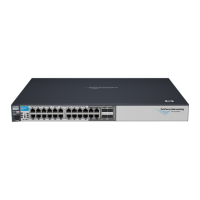8 User Interfaces
This section describes the three user interfaces (UIs) that can be used to configure, manage, and
monitor the VLS over the web, remotely over the LAN, or through a serial connection. It also provides
instructions on how to open and close a connection to the VLS for each type of user interface.
User Interface Requirements
VLS user interfaces lists the VLS user interfaces and their requirements. Of the three user interfaces,
Command View VLS should be used in most circumstances. It is the most intuitive and easiest to learn
and use.
Multiple user interface sessions may be open at once.
Table 2 VLS user interface requirements
For more informationConfigurationRequirementsUser interface
See “Command View
VLS” on page 103.
10/100/1000 BaseT
Ethernet port configured
with an appropriate IP
address, host name,
domain name, subnet
mask, and gateway
Can login as
Administrator or User
PC or workstation network
attached to the VLS node
0 running Microsoft Inter-
net Explorer 6.0 or high-
er, or Netscape Navigat-
or 4.7 or higher
Command View VLS
See “Secure Shell and
Serial User Inter-
faces” on page 108.
10/100/1000 BaseT
Ethernet port configured
with an appropriate IP
address, subnet mask,
and gateway
Can login as
Administrator only
Secure shell client (such
as PuTTY) network at-
tached to the VLS node 0
Secure shell (ssh)
See “Secure Shell and
Serial User Inter-
faces” on page 108.
Only one serial
connection at a time is
permissible
Can login as
Administrator or
Emergency user
Null-modem cable at-
tached to the VLS node 0
and terminal emulation
program (such as Win-
dows Hyperterminal™)
configured to 115200
baud
Serial
Command View VLS
Command View VLS is a web browser-based GUI that you can use to configure, manage, and monitor
your VLS through a LAN. Command View VLS provides the following:
HP StorageWorks 12000 Gateway Virtual Library System User Guide 103

